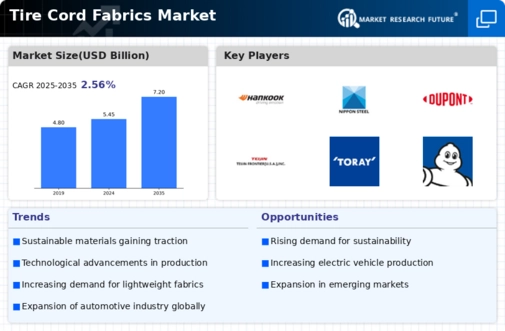Top Industry Leaders in the Tire Cord Fabrics Market

The tire cord fabrics market, a vital yet often overlooked thread in the tapestry of the automotive industry, These seemingly simple woven fabrics, composed of high-tensile fibers like polyester, nylon, and aramid, are the silent heroes behind the smooth performance and safety of our tires. But beyond their physical function lies a complex competitive landscape, where established giants and nimble innovators battle for market share.
Strategies Weaving Success:
1. Material Mastery: Diversifying product portfolios beyond traditional polyester to include high-performance options like nylon and aramid allows players like Kolon Industries and Bekaert to cater to specific needs of different tire segments, from passenger cars to heavy-duty trucks.
2. Technological Twists: Research and development are key to staying ahead of the curve. Companies like HYOSUNG ADVANCED MATERIALS invest in advanced weaving techniques and fiber treatments to improve tear strength, heat resistance, and fuel efficiency of tire cord fabrics.
3. Global Reach, Local Threads: Expanding into emerging markets like China and India, where the automotive industry is booming, is crucial for growth. SRF Limited, an Indian player, has leveraged its local presence and cost-competitiveness to gain a strong foothold in this region.
4. Vertical Integration: Gaining control over the supply chain by acquiring raw material sources or manufacturing facilities, as Indorama Ventures has done, can improve cost-efficiency and quality control.
5. Sustainability Stitches: With the growing focus on green technologies, developing eco-friendly production processes and offering recycled or recyclable tire cord fabrics is becoming a key differentiator. Century Enka Limited, for instance, is pioneering the use of recycled PET bottles in their fabric production.
Factors Shaping the Fabric of Market Share:
1. Material Choice: The type of fiber used in the fabric depends on the tire's intended application and performance requirements. Polyester dominates the passenger car segment, while nylon and aramid find favor in high-performance tires.
2. Cost Competitiveness: Price remains a significant factor, especially in bulk purchases. Asian manufacturers like Zhejiang Jiale Ceramic Balls Co., Ltd. often offer cost-effective options, while European and American players command premium prices for high-quality products.
3. Technological Advancements: Players that constantly innovate and offer advanced solutions, like improved wear resistance or lighter fabrics, can gain a competitive edge.
4. Regional Trends: The growth of different vehicle segments in various regions influences demand. For example, the rise of electric vehicles in Europe is driving demand for specialized tire cord fabrics with enhanced durability and lower rolling resistance.
5. Environmental Regulations: Increasing focus on sustainability could lead to demand for eco-friendly tire cord fabrics or those used in clean energy technologies.
Key Players:
- Indorama Ventures Public Company Limited
- Kolon Industries Inc.
- SRF Ltd.
- Teijin Ltd.
- Century Enka Limited
- Toray Hybrid Cord, Inc
- KORDÁRNA Plus a.s.
- Hyosung Corporation
- Madura Industrial Textiles Ltd.
- Cordenka GmbH & Co KG
- Firestone Fibers & Textiles
- Shenma Industrial Co., Ltd.
- Milliken & Company
- JunmaTyre Cord Company Limited
- Sohrab Group
Recent Developments:
July: Saint-Gobain announces a new production facility in India to cater to the growing demand for high-performance tire cord fabrics in the region.
August: Kyocera Fine Ceramics develops a new type of aramid fabric with exceptional heat resistance, specifically designed for use in high-performance tires for racing and extreme conditions.
September: Zhejiang Jiale Ceramic Balls Co., Ltd. partners with a European distributor to expand its reach in the European market, aiming to challenge established players.
October: Wuhan Jinrui Wear Resistant Materials Co., Ltd. secures funding for a research project aimed at developing new lightweight and fuel-efficient tire cord fabrics for electric vehicles.
November: The European Union proposes new regulations on the use of certain chemicals in tire production, potentially impacting the demand for some traditional tire cord fabric treatments.
December: A study published in a leading automotive journal highlights the potential of using bio-based fibers in tire cord fabrics, opening up new avenues for sustainable production in the future.









